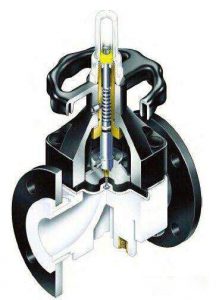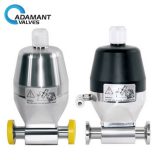Sanitary diaphragm valves have a very basic body construction.
Body
As we all know, the stem of a sanitary diaphragm valve does not rotate.
- The stem of this valve can be non-indicating, which means that the handwheel rotates a stem bushing to engage the stem threads. This moves the stem and attached compressor up and down. The diaphragm is attached to the compressor. Non-indicating bodies can use sealed bonnets with a seal bushing.
- The stem can also be indicating. This design operates the same as the non-indicating design but the stem is longer and extends up by the handwheel. Indicating bodies can use a sealed bonnet with a seal bushing and O-ring.
The bonnet of a valve is the cover of the top of the valve; it contains the non-wetted portion of the valve, the compressor, and the handwheel mechanism.
The bonnet is then bolted to the valve body. Diaphragm valve bonnets are quick opening and lever operated. This type of bonnet is interchangeable with the standard bonnet on conventional weir-type bodies. The lever opens and closes the diaphragm with a 90° turn. Diaphragm valves can also be used in vacuum services using a bonnet construction up to 4 inches in size.
For larger valves, a sealed, evacuated bonnet should be used.
A compressor is required to operate the diaphragm in the valve. The compressor is located above the diaphragm and below the handwheel stem. The compressor is rounded and shaped much like the body’s flow passage.

Actuator
The valve actuator operates the stem and disc to open and close the valve. There are several types of actuators to consider depending on the needs of the system such as the torque necessary to operate the valve, speed and the need for automatic actuation.
Actuated varieties can offer features an adjustable opening, positioners for precise flow control, and electric relay of valve position.
Hydraulic actuators provide for semi-automatic or automatic positioning of the valve. They are used when a large force is required to open the valve, such as the main steam valve. With no fluid pressure, the spring force holds the valve in the closed position. Fluid enters the chamber, changing the pressure.
Thermally actuated valves are activated by a change in media temperature. Temperature and pressure are present and the valve will open or close to adjust to the desired specifications.
When selecting an actuator it’s important to consider the output power, which is used to overcome resistance and ensure high degree sealing and valve opening.
Manual/hand operated actuators use a hand-wheel or crank to open or close the valve. They are not automatic but offer the user the ability to position the valve as needed. Manual actuators are used in remote systems that may not have access to power, however, they are not practical for applications that involve large valves. Gearheads can be added for additional mechanical advantage and open/close speed.
Electric motor actuators permit manual, semi-automatic, and automatic operation of the valve. The high-speed motor is usually reversible and used for open and close functions. The actuator is connected through a gear train to reduce the motor speed and thereby increase the torque. The actuator is operated either by the position of the valve or by the torque of the motor. A limit switch can be included to automatically stop the motor at fully open and fully closed.
Pneumatic diaphragm valves can be automatic or semi-automatic. They function by translating an air signal into valve stem motion by air pressure acting on a diaphragm or piston connected to the stem. These actuators also use a spring and can be programmed in a variety of manners, such as using the air pressure to open the valve and spring pressure to close the valve or vice versa. Pneumatic actuators are fast-acting for use in throttle valves and for open-close positioning.
For more information, please visit http://www.adamantvalves.com/




Recent Comments